Blog
December 10th, 2009
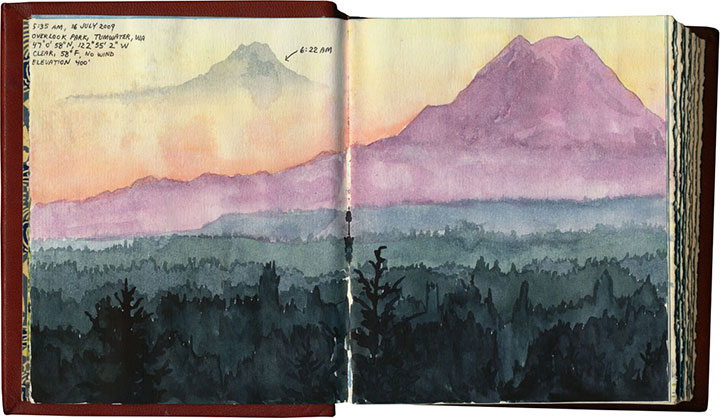
After nearly a year, image-gathering for my Mt. Rainier artist book is finally coming to an end, and I’m starting to make the final illustrations. I have a huge stack of sketches, scribbles and recorded data, and thousands upon thousands of photos to sift through. This month and next are scheduled for the all-important (and terrifying) process of Figuring Out How the Heck to Make It Work—physical mock-ups, final compositions, text-writing, etc. But before I could move on with a clear conscience, I had one last far-away location to cross off my research list: Portland. And for some reason, the stars just weren’t aligning for me.

My first attempt this summer was also my first-ever trip to the city, so I had to location-scout with a blank mental map—and when I finally found what I was looking for, it was too hazy to see anything anyway (hence the dotted line where Rainier should be). Since Portland is 140 miles away, I couldn’t just try again any old time I pleased. As the months went by, I became increasingly frustrated—the location I visited over the summer (Larch Mountain) is inaccessible in the winter, and although I had another spot in mind, my schedule and the weather (which was way harder to pin down than an open travel day!) just couldn’t find anything in common; the last few months have been typically Northwestern, with plenty of rain, fog and drear for a volcano to hide behind. Finally, last week, it seemed I had my chance. T-town was socked in with pea-soup fog, but since the previous day had started the same way and ended in sunshine, I decided to go for it. As I cleared the Puget lowlands and the fog lifted, I caught crystal-clear glimpses of Rainier to the east as I went, and my confidence rose. I wouldn’t know for sure until I got there, but the sunny weather seemed like it would hold. I made good time to Portland, wound my way up to Council Crest Park, jogged up to the viewpoint and faced north—
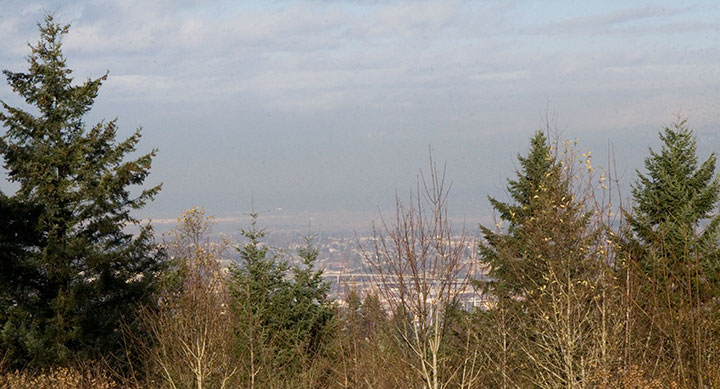
—and saw that Mt. Saint Helens didn’t get the memo. It had its own private weather system blocking Rainier from view.
It was a long drive home that night.
The last few days were torture. The weekend taunted me with sunny mornings and cloudy afternoons (good thing I didn’t take the bait), and the perfect weather went untested Monday and Tuesday while I taught class and kept appointments instead. By Tuesday night, I was sure I’d missed my last chance, and resigned myself to leaving Portland out of the book. But yesterday dawned cold and flawlessly clear, and I was astonished to find my calendar empty. I left the Tailor an incoherent voicemail at work (“I’m going right now! I’ll be back tonight!”) and jumped in the car. Exactly two hours and twenty-three minutes later, this is what I saw:
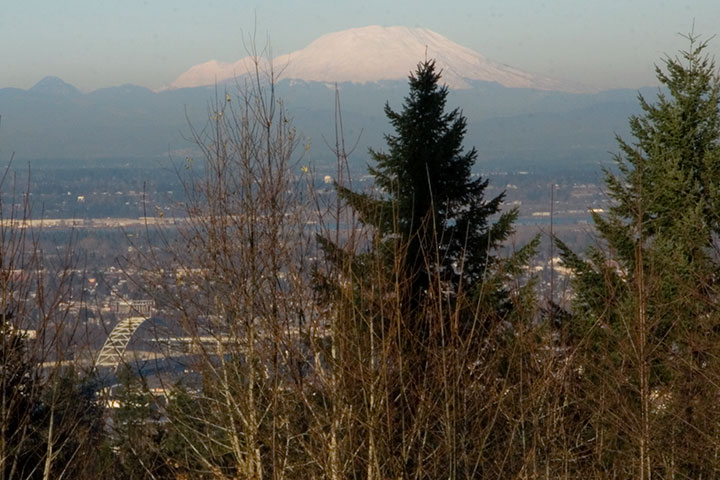
That’s St. Helens in front, with Rainier just peeking around her left shoulder.
And here’s the illustration that resulted from all this work:
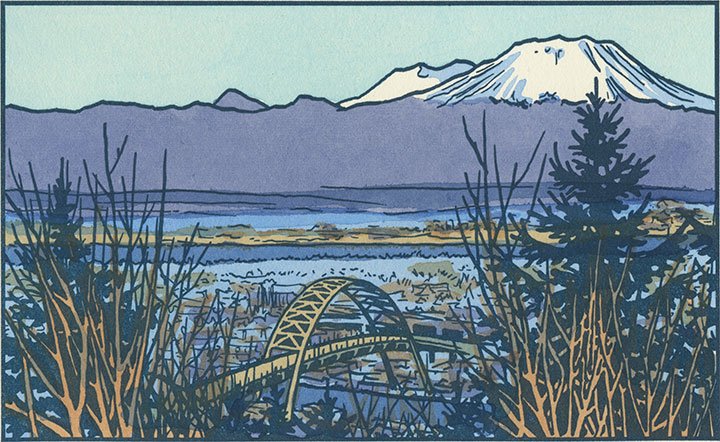
And in case I had any doubts about one image being worth all this trouble, Portland offered me a little bonus—a compositional jewel that I could never have dreamed up on my own:

The City of Roses was still, impossibly, in bloom.
November 20th, 2009
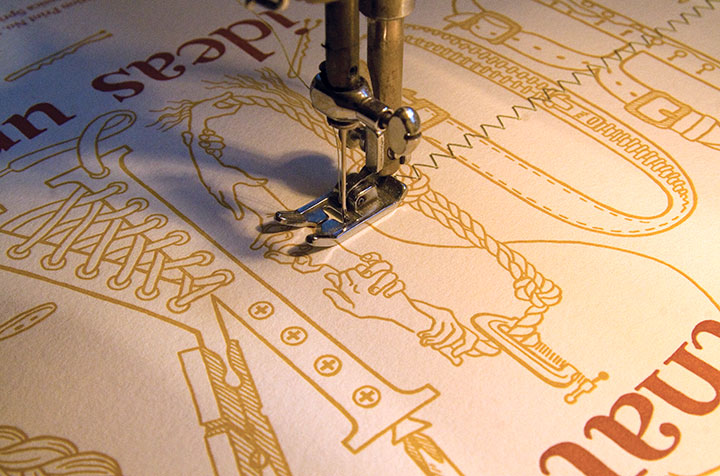
People who stop by the house for the first time must really think I’m strange. Never mind our own personal farmers market residing in the attic and root cellar—these days the place looks like the the visual-art equivalent of Willy Wonka’s Chocolate Factory, with snips of paper, rows of identical bird portraits, bright watercolor cakes, brushes and pencils, boxes of envelopes, shipments waiting to go out, and stacks of prints covering every horizontal surface. It certainly gives new meaning to the term “cottage industry.” I guess that’s what happens when you decide to double your inventory right before the holidays.
This week, though, there was a new element to the chaos: the drone of the sewing machine. And now that all the threads are tied off, Jessica and I are finally ready to unveil a little secret we’ve been sitting on for a few months. Seattle Center for Book Arts (SCBA) asked us to create their second-annual Special Edition Print, and I’m happy to report that they’re now available for sale.

Each year the Special Edition Print has the theme of “Unbound,” and the folks at SCBA challenged us to interpret it how we liked. So instead of our customary work with famous quotes, Jessica whipped up a little gem of her own. We started thinking about all the ways something (not just a book!) might be bound or unbound, which led us to visions of lacing, pinching, tying, zipping, braiding, taping, clamping, buttoning, stitching, buckling, hammering, gluing, clipping, lashing and pinning. Which then, of course, gave me free reign to make an absolute, giddy mess of things, and scatter fasteners and notions all over the page. My favorite additions to the drawing, though, are the bread tags. My grandmother had a whole drawer full of them in her kitchen (did she ever use them, or did I just discover the source of my pack-rat tendencies?), and I loved the way they rattled around in there. So Nana, this one is for you.
Everything is hand-drawn and lettered (as per usual), then letterpress printed in copper ink and an ochre color that is precisely the shade of those little Bit o’Honey candies (remember those?). This time, though, we’ve added a little extra goodie: a line of zig-zag stitching in cotton thread, in exactly the green of copper patina. SCBA is the only place to get these prints, so if you’d like to play a little game of Button, Button, Who’s Got the Button, you can get your copy here.
November 10th, 2009
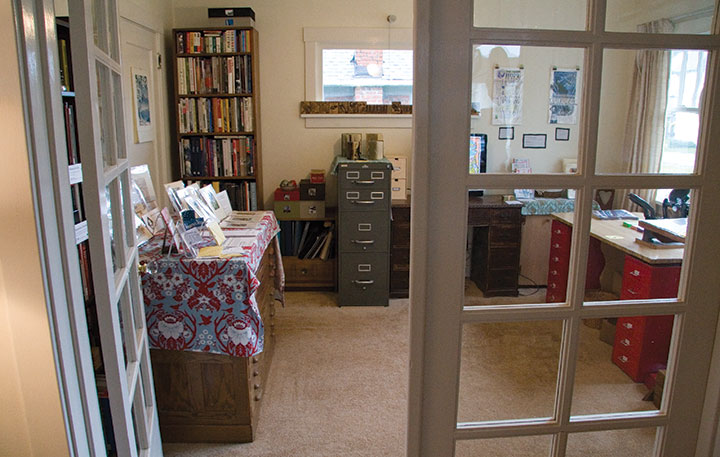
Yowsa! When Tacomans say they’re into art they’re not kidding. Despite absolutely horrendous weather, we had 130 visitors to the studio this weekend! (Hmm…which, oddly enough, is almost exactly the square footage of the space. This is how things looked before that first knock on the door Saturday.)
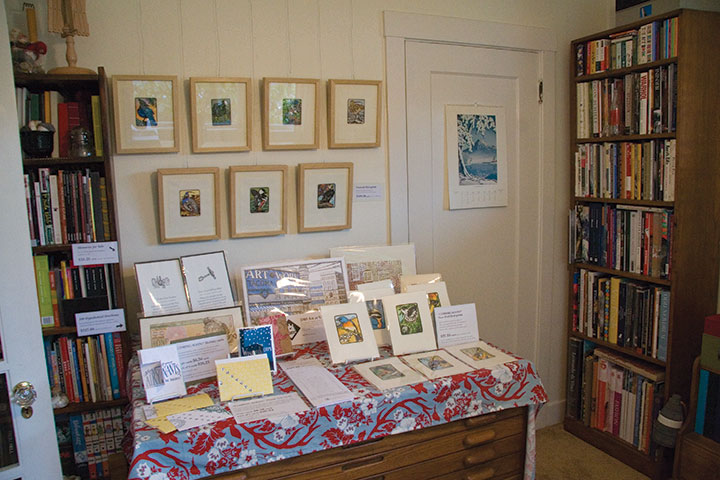
So a vast, colossal thank you is in order for all of you who braved the downpour and jet-propelled ice pellets to get here, and then shoehorned yourselves into the studio to order prints, start a subscription, get your hands dirty on press, or just say hello (sorry the Tailor’s fabulous cookies ran out so quickly). Friends stopped by for a quick hug, gaggles of kids discovered the joys of printing, and one person immediately ran out and bought her own Kelsey press that very same day (you know who you are!), courtesy of Tacoma’s Antique Row. Lots of people returned the second day, and I lost count of all the newcomers and fresh faces. Everybody came with intelligent questions and thoughtful insight, and I’m just overwhelmed by all the kind words of welcome and encouragement. And as if that weren’t gratifying enough, when we finally closed up shop on Sunday, everything was just as tidy as it was on Friday night—no mud tracked in, no prints out of place, no ink straying beyond the demo table. You people are amazing! Sign me up for next year.
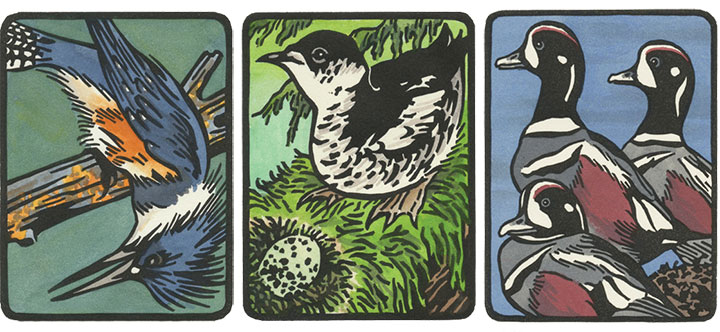
In the meantime there’s still quite a lot of finishing-up to do before the holiday rush consumes my brain (I’m still not over the weird sensation of being on the other end of holiday retail). I’m going to hold onto Marie Curie until Thursday so I can tie up some other loose ends first, so look for it online then.
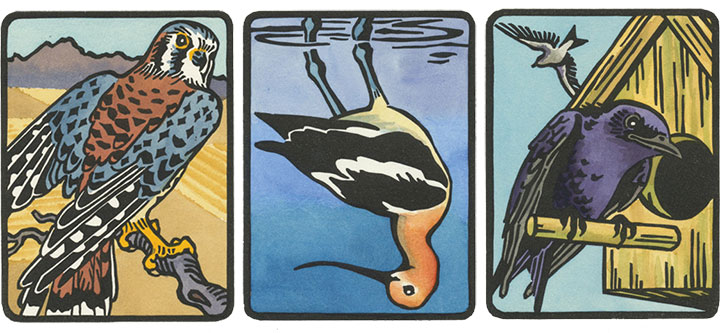
For now, here’s a quick peek of the new birds that were unveiled this weekend. I’m still finishing up the editions (you should see my little watercolor assembly line), so if you placed an order at the studio tour, I’ll be contacting you in the next couple of weeks.
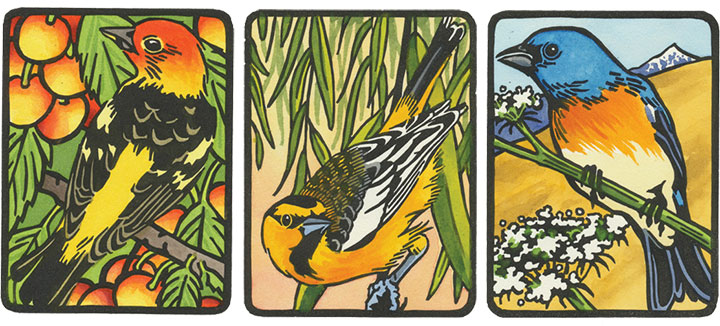
If you’re local but you missed out on the tours this weekend, these little guys will be available at the next Tacoma is for Lovers Craft Fair, held at the inimitable King’s Books on Sunday, November 22, from noon to 5 pm. And for the online world, I’m posting them one-at-a-time, every couple of days in the Etsy shop—just so I don’t get too far ahead of myself!
October 27th, 2009
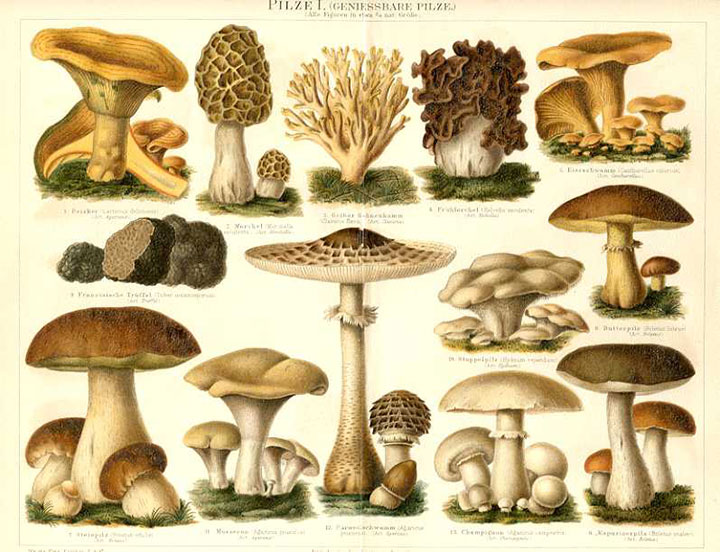
Now that we live in a vacation destination, we tend to get a lot of out-of-town visitors. We have a list of favorite places to take first-timers, so we can often be found at places like the Pike Place Market, Point Defiance, and Mt. Rainier with house guests in tow. When a pair of French foodies arrive on your doorstep, however, it’s a whole ‘nother ballgame. Our friends Gilles and Jean-Philippe had just one major request for their visit last weekend: mushroom hunting. Since it’s chanterelle season and the weather was good, Saturday seemed like a good day to lace up our hiking boots and grab our pocket knives.
Disclaimer! The Tailor and I are not experienced mushroom gatherers, so we’d never try this on our own—incorrectly identifying edible fungi is not a mistake one wants to make. Even the most detailed books can’t replace the presence of a skilled guide, so if you don’t have your own French mycophile on hand to take you hunting, skip the risk and buy a bag of chanterelles at the farmers market!
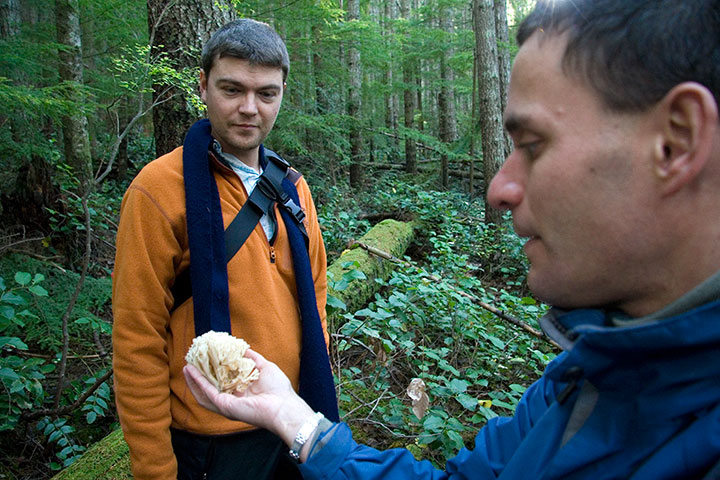
As far as dinner ingredients go, we came away empty-handed—the conditions just weren’t right. But as a crash course in the sheer diversity of local fungi, it was a spectacular day; we found several dozen different varieties ranging from beautiful to bizarre; delicate to disgusting.

We did find a few edible species (these orange peel cups were a beautiful and exciting highlight), but nothing worth turning into a meal. So the day turned out to be more of a scientific field trip—certainly a worthwhile adventure in its own right.
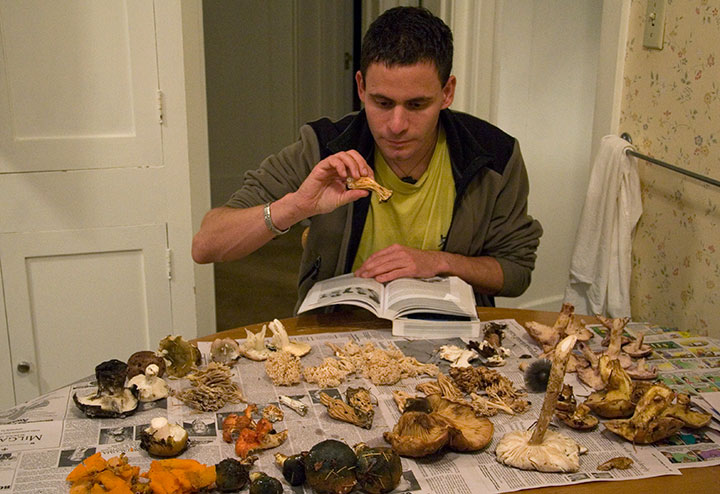
When we got home, Gilles spread out our haul and set to work identifying, making us laugh whenever he called out something strange (stinkhorn, elfin saddle, hedgehog—called sheep’s foot or pied-de-mouton in France).
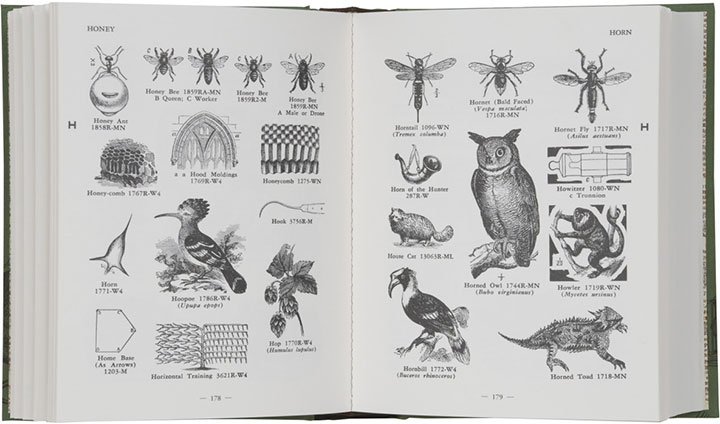
As for me, all this mushroom-naming reminded me of the newest addition to my reference library: the stunning Pictorial Webster’s, by book artist John Carrera (for a mind-blowing art experience, check out the video on the process behind the book here). So I took a page out of his book (sorry, I couldn’t resist), and did a little visual taxonomy of my own.
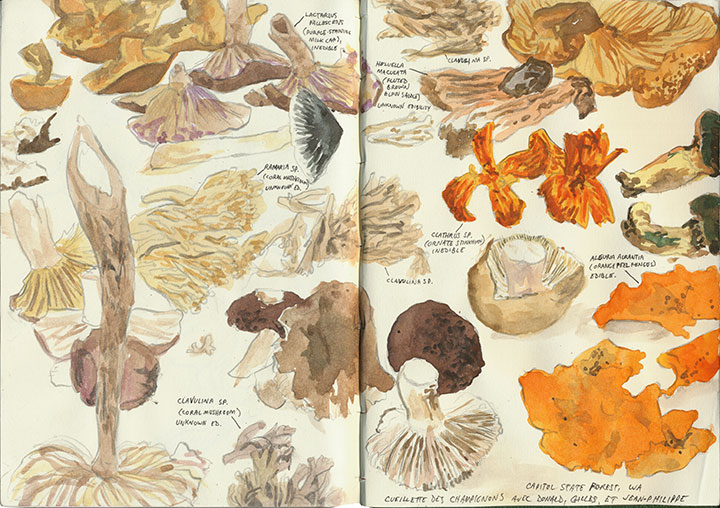
Jean-Philippe, meanwhile, had the best idea yet: purchasing a pound or two of fresh chanterelles, and putting his mad French cooking skills to work. The sumptuous champignons dish he whipped up disappeared into our mouths long before I thought to grab the camera, but I did remember to ask for the recipe:
Chanterelles à l’improvisation
– 1 1/2 pounds fresh chanterelle mushrooms, halved
– 1/2 cup bacon (3 slices or so)
– 1 medium yellow onion, chopped
– 4 to 5 Tbsp olive oil
– 1/4 cup dry white wine (the Muscadet we had on hand was great)
– dry parsley to taste (fresh is better, but we didn’t have any)
– salt and pepper to taste
Brown the bacon until crisp, then break into small pieces. In a separate, large pan (so as not to overpower the mushrooms with the flavor of bacon fat), sautée the onions in olive oil over medium-low heat until lightly browned. Add the chanterelles, bacon, salt, pepper, and white wine, and sautée until the mushrooms are slightly limp and drained of most of their water content (oh, say 5 or 6 minutes). Season with parsley at the very end, then serve either alone or over brown rice. Watch the dinner conversation devolve into a series of satisfied grunts.
October 14th, 2009
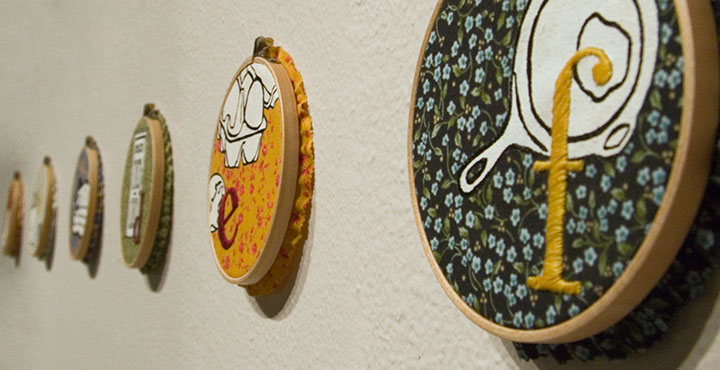
When I walked into the PLU Gallery this morning to document the Mnemonic Sampler show when it opens, my brain had somewhat of a short circuit. Since I was out of town for the past few days, all of the installation work was done for me (thank you a million times over, Heather C.!)—so this was the first time I’d laid eyes on the work since framing it up and chucking the pieces in a box. I somehow couldn’t connect the finished work on the walls with the crazy, chaotic process of the past few months. It seemed so simple, like this was somebody else’s show, and all the nail-biting and never-ending futzing I’d been doing was for some other project that would remain unfinished forever. But I did finish it—and there it is!
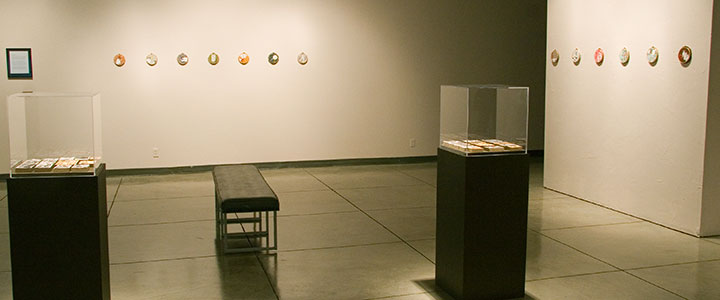
I was nervous about the possible absurdity of having twenty-six small pieces in a colossally huge space, but somehow, it works. Heather ingeniously used lighting and visual breaks to transform the gallery into a space that draws the viewer in and creates an intimate experience—which is exactly what I hoped for. Heather, I owe you big.
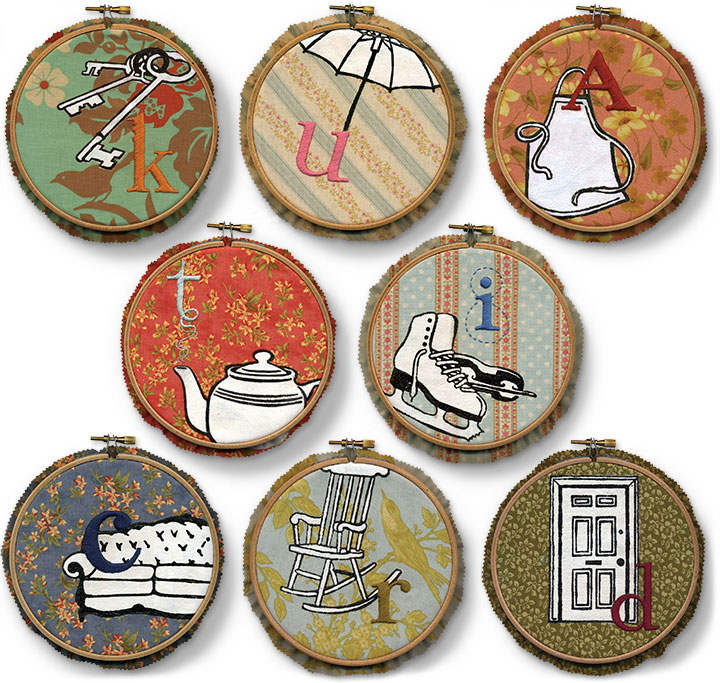
On to the work itself. Here is the artist statement for the exhibit:
The alphabet is one of the first lessons we learn as children. From the beginning we learn to use it as a mnemonic device—just like “Roy G. Biv,” or “Every Good Boy Deserves Fudge”—assigning meaning to our world by associating symbols with each letter. Because the alphabet is one of our most basic and effective memory tools, we are drawn to it as both a visual and narrative archetype. It’s not surprising, then, that the abecedary is somewhat of a staple among book artists.
Just as we use our ABCs as a memory aid, our possessions help us create the concept of Home. No matter what our economic station, living situation, or domestic permanence, we all tend to share similar symbols of comfort and nostalgia. These ideals are embodied in the everyday objects around us—those mundane materials we take for granted, yet without which we would sense something lacking. As someone who has never had a picket fence, who grew up in a nomadic military family, and who has lived her entire life with relatively few possessions, the archetypal Home should seem foreign to me. Yet the same mnemonic triggers exist in my mind; the same objects attract me.
Mnemonic Sampler collects and files our household icons, gathered together like the stitched and quilted samplers of our mothers and grandmothers. The hand-stitched alphabet enumerates my, your, our trappings, shuffling our collective domestic inventory like the old card game of Memory. Each symbol is familiar; each object is Ours, whether we actually possess it or not. Together they sketch out a Home—real or imagined; longed-for or spurned; past, present, or future.
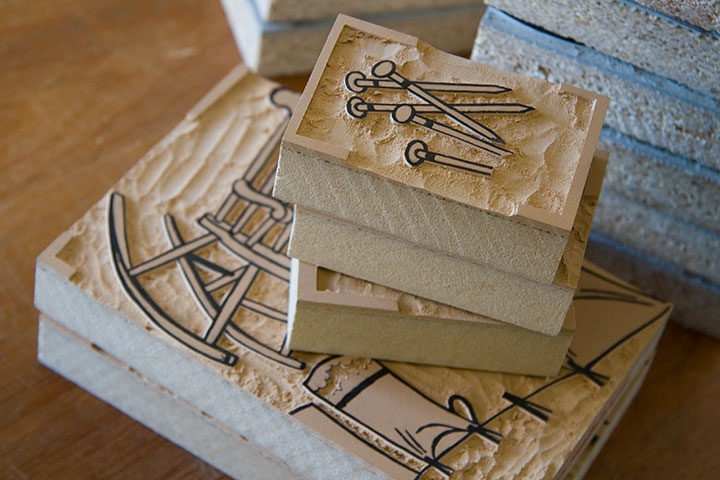
Mnemonic Sampler is a collection of monoprints, which means that instead of an edition of multiples, each print is created in such a way that it can’t exactly be reproduced. This technique results in a one-of-a-kind, totally unique piece—and is often more closely related to painting than printmaking. These pieces are printed from reduction-cut linoleum blocks—meaning both print colors are carved from the same block.
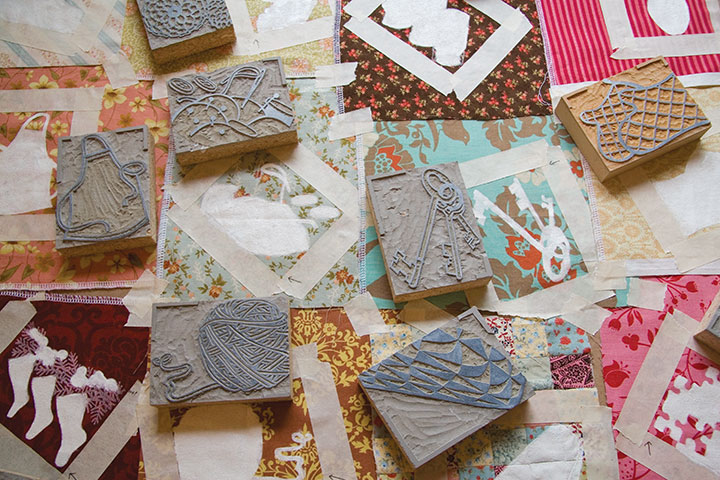
So once the second design is carved, the first color cannot be printed again.
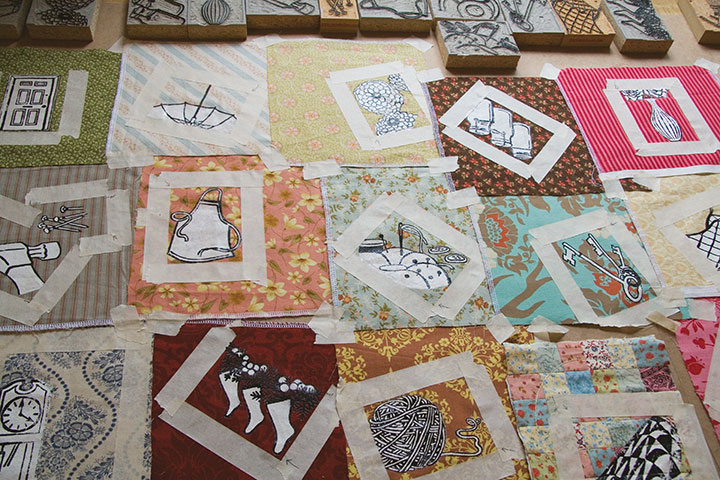
Designing these pieces was an intuitive process, consisting of both logical and intangible choices of fabric and pattern compositions. Because the design stage was so fluid (almost semi-conscious at times), it really wasn’t possible to do the printing on a press. Instead, each impression was made literally by hand, using masking tape to aid in color registration.

“Q” has an extra conceptual level, since the fabric background is a patchwork “quilt” in its own right. Like everything else about the series, the patchwork is sewn by hand, using the English paper piecing technique.
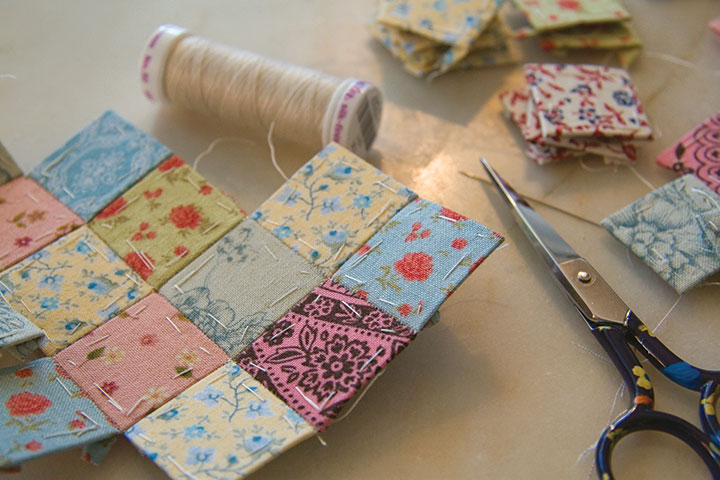
This was my first attempt at paper piecing, and I’m pleasantly surprised at how quick and accurate it is. Instead of folding and ironing every tiny piece, then wrangling a sewing machine, each patch is wrapped around a paper template and basted down, then whip-stitched together into a block.
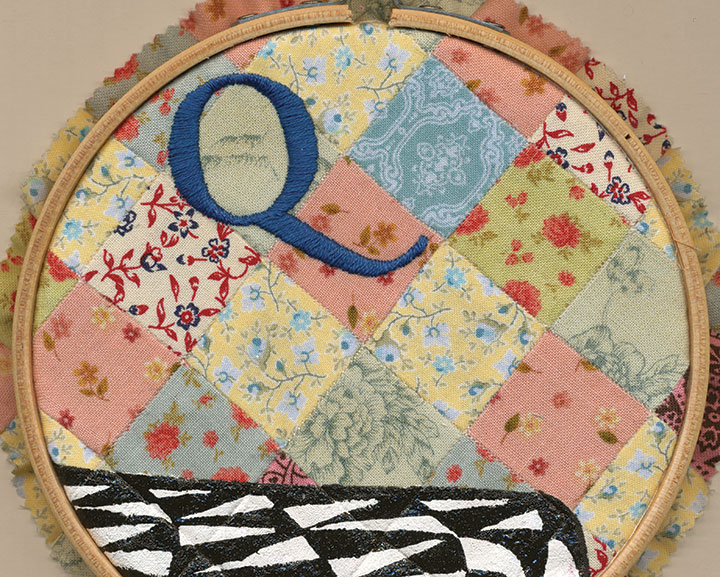
The result is a precise little quilt—perfect for embroidery.
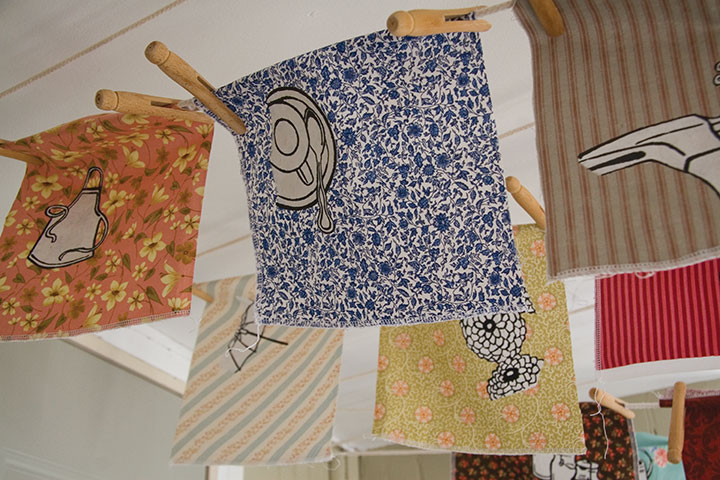
I can’t believe how long it took to complete every step of the process—and yet how quickly everything came together at the end. So you can bet I’m excited about celebrating at the opening tonight. And besides, I’m interested to see if the household objects I chose will resonate with viewers; it wasn’t easy to narrow things down to twenty-six letters of the alphabet, so I picked those objects that had the most meaning for me.
So how about it—what spells “Home” for you?
October 2nd, 2009
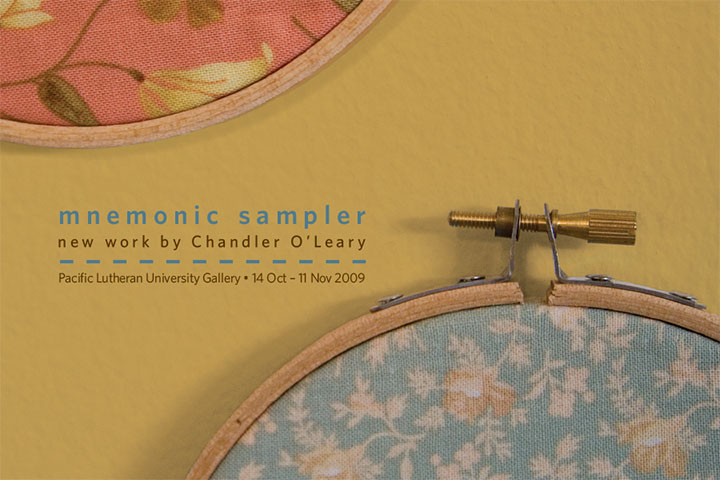
Finally, something tangible to show you! This is the point where all of the elements for my new body of work are just starting to come together. The past couple of months have been somewhat of a nail-biter—sometimes I wonder what possessed me to create twenty-six new pieces for a last-minute show. Now that the promo postcards (see above) are in hand and I can see the finish line, however, I can tell that my instincts knew what they were doing.
Mnemonic Sampler is my new solo show, opening October 14 at the PLU University Gallery. Here are the details:
Mnemonic Sampler: An Abecedary by Chandler O’Leary
October 14 to November 11
University Gallery, Ingram Hall
Pacific Lutheran University, Tacoma, WA
Opening Reception: Wednesday, October 14, 5-7 pm
On display will be something of a room-sized artist book, consisting of twenty-six hand-embroidered monoprints on calico (a monoprint is the opposite of an edition, a one-of-a-kind piece). Together the prints form an abecedary, or alphabet, and tell the story of how our concepts and ideals of “Home” are linked to the everyday objects that surround us. More on this topic when the show opens, but for now, here’s a peek (since the work is not quite finished, a peek is all I’ve got for now):
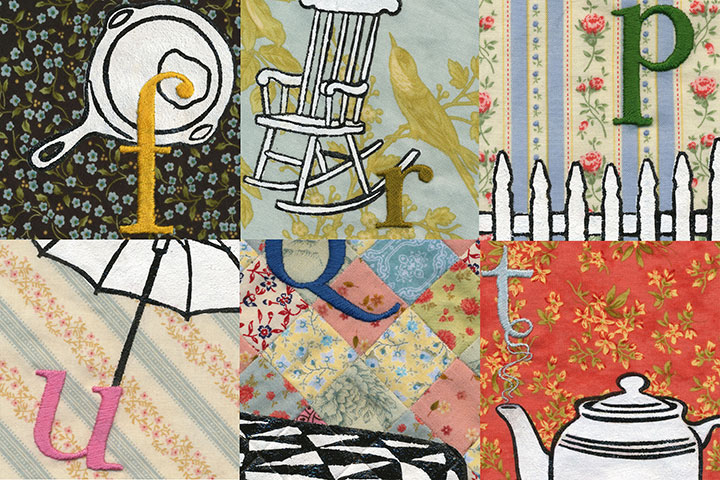
Many, many thanks to the talented and infinitely helpful Katie S. at PLU, who took care of having show postcards printed and mailed (!), orchestrated every logistic detail, and who has made the whole process as smooth as pumpkin pie. I would have long since lost my mind if it weren’t for you, Katie!
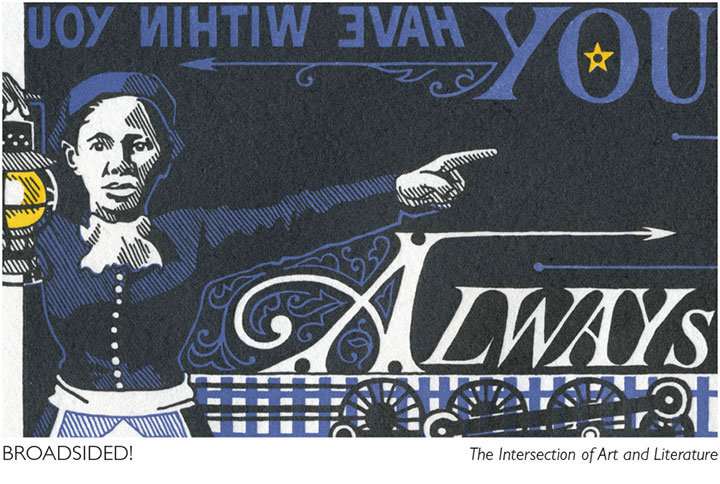
Speaking of amazing women who run galleries, another big thank-you and shout-out to Laura Russell of 23 Sandy Gallery in Portland, for featuring End of the Line on the promo materials for another new show that opens tonight. Broadsided! is national, juried exhibition of letterpress broadsides featuring the work of thirty-four artists. Here are the details from the 23 Sandy website:
Broadsided! The Intersection of Art and Literature
October 2-31, 2009
23 Sandy Gallery
623 NE 23rd Avenue
Portland, OR 97232
Opening reception: Friday, October 2, 6-9 pm
Before books, before blogs and before broadcasts, there were broadsides. Historically, single sheet broadsheet posters were ephemeral in nature. They were developed in the fifteenth century for royal proclamations, official notices and even advertisements. Today, broadsides hang at the intersection of art and literature. Letterpress printed broadsides are valued as fine art designed and printed by a true craftsperson; but also as fine literature featuring stellar poetry or prose.
The best part about the Broadsided! exhibit is that you don’t have to be local to see it! Laura has set up a fantastic online catalogue of the work in the show, with photos and the complete text from each broadside. Nothing beats seeing art in person, of course, but if you can’t make it to Portland this fall, this is a brilliant alternative.
September 25th, 2009

For the past several months, the buzz here in T-town has centered around the Luzon building on Pacific Avenue, a 119-year old structure that, depending on whom you ask, is either an architectural gem or a decaying eyesore. (As you can probably guess, I fall into the first category.) Above is an image of the Luzon in its infancy; this photo is printed from a turn-of-the-century glass plate negative found in Jessica Spring’s attic (and is part of her artist book, Parts Unknown). The thing about the Luzon that has made it such a sore spot around here is that it’s not just a living piece of history—at the time it was built, it was something of an engineering marvel. Co-designed by Daniel Burnham, who went on to design the Flatiron Building in New York and became one of the pioneers of modern multi-story structures, the Luzon was one of the first buildings in America to have steel columns. That makes it a direct ancestor—the great grandpappy, if you will—of the American skyscraper itself.
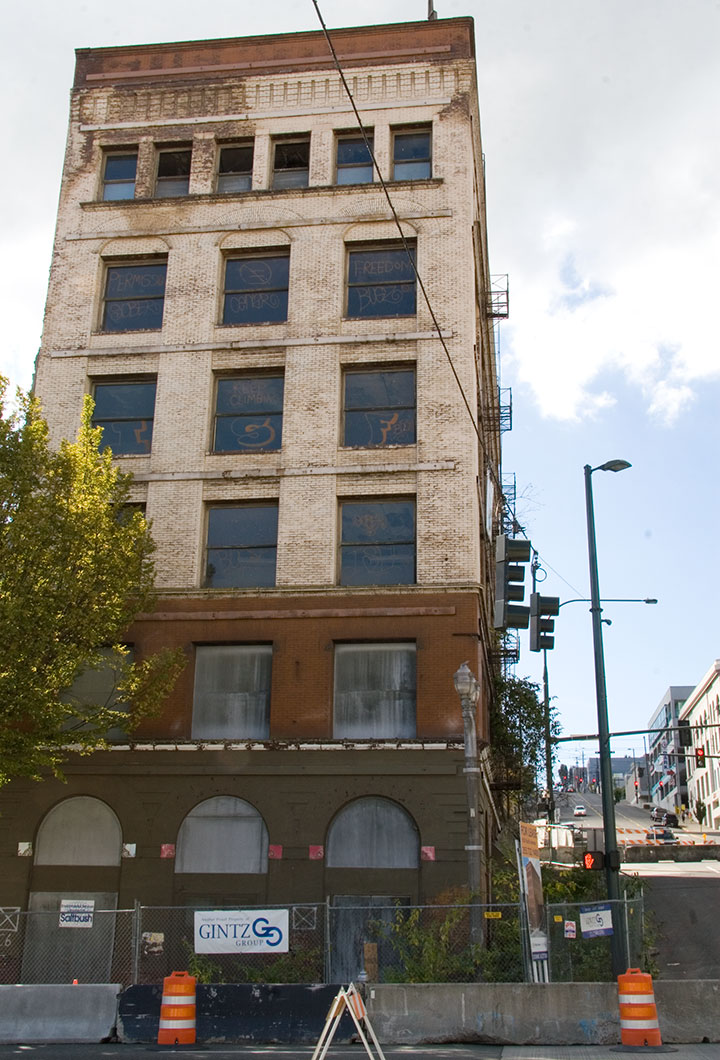
This is the sorry state of the Luzon today. Even though it is on the National Register of Historic Places, and is one of only two Burnham & Root buildings remaining on the West Coast, it has been allowed to decay, apparently beyond the point of no return. While each of many redevelopment schemes over several decades has fallen through, the building has become increasingly derelict. Now that the adjacent property—which provided structrual stability—is long gone, the Luzon is crumbling under its own weight. The City has even closed the surrounding streets in case of a collapse.
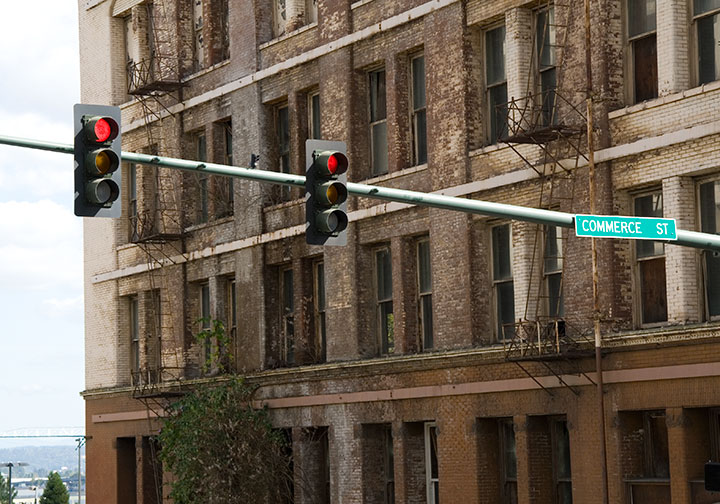
Oh, and there’s a tree growing out of it. I don’t think that was part of the original plan.
Well, whether it was a ploy to get around the Historic Register for a development scheme, or the powers that be just dragged their feet for too long (or some combination thereof), the detractors are finally getting their wish. The building is slated for demolition tomorrow morning. So now everyone (including me) has got the Luzon on the brain.
Last week the inimitable artist/cartoonist RR Anderson (who has a few choice words himself about the Luzon’s fate) challenged me to compete in his weekly sidewalk chalk contest, the Frost Park Chalk Challenge. I was looking for an outlet for my Luzon frustration, so I accepted. I grabbed a hunk of charcoal, a handful of communal Crayola chalk, and headed for a highly visible chunk of concrete wall to create a public altarpiece.
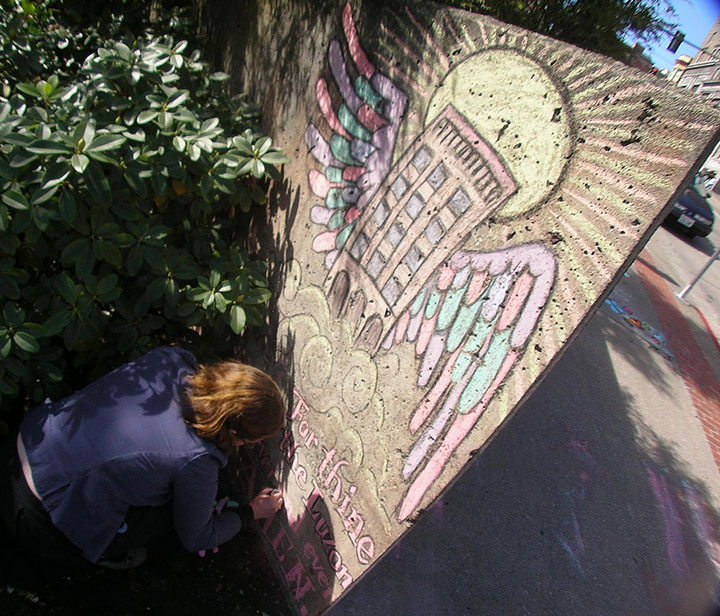
Photo by R.R. Anderson
My little Ascension doodle earned me a lot of comments from passers-by and the title of BEST ILLUSTRATOR IN THE UNIVERSE (OF TACOMA) for the week (thanks, guys!).
But sidewalk chalk isn’t exactly archival, and I wanted to make a somewhat more lasting statement. Here’s where letterpress comes in. Jessica and I were commissioned to design and print this year’s poster for Art At Work Month, hosted by the City. So since the theme for the overall Art At Work design this year is “ghost signs,” we decided the poster would be the perfect opportunity for a little cameo.
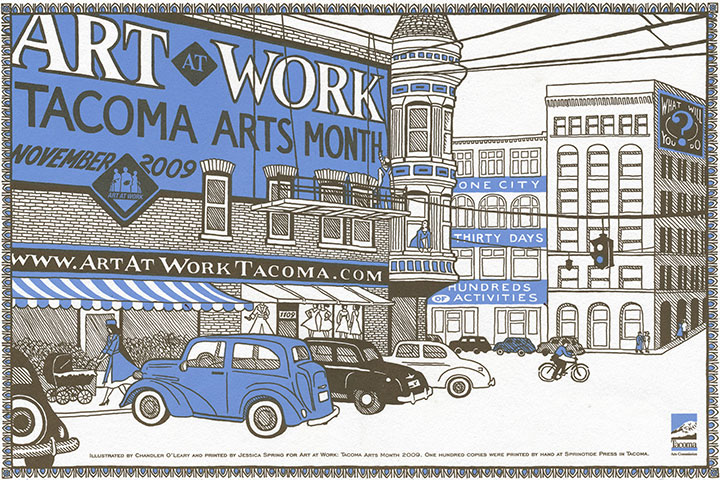
The original posters are letterpress printed in an edition of 100, and will be sold by the City in November, as part of the festivities. But a reproduction will also be inserted into every Art At Work brochure—over 10,000 of them. So come November Burnham’s gift to Tacoma will be long gone, but it’ll feel good to know that we did our part to make sure the Luzon is everywhere we turn—at least for a little while longer.
Edited to add: now that Art at Work month is over, you can now find the last few copies of the letterpress poster in the shop!
September 22nd, 2009
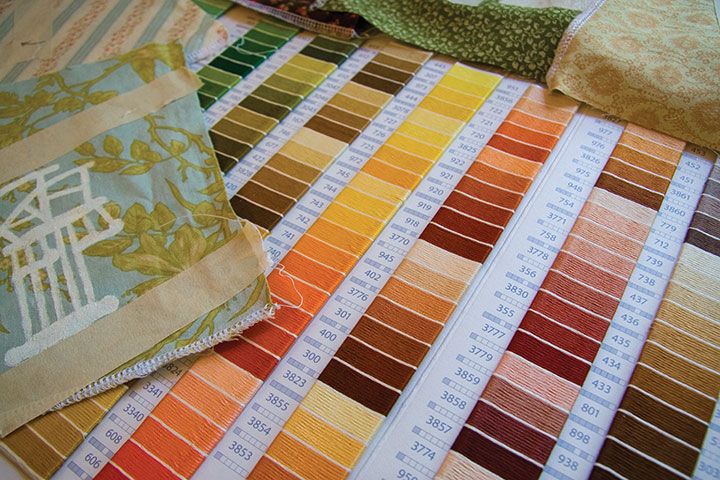
Swatch books are very near the top of my list of Favorite Things Ever. There is something so satisfying about having every color, pattern, texture, or finish right at your fingertips. I love sitting at my table, with a cup of tea in hand and six hundred sample chips spread out before me, ready for some serious color theory. (In case you’re wondering, this is the amaze-a-crazy DMC embroidery floss über color card. Well-made swatch books like this tend to be expensive to produce, and impossible to find once they go out of print. So if you’re into this sort of thing, I’d suggest snagging your copy before they decide to quit selling them.)
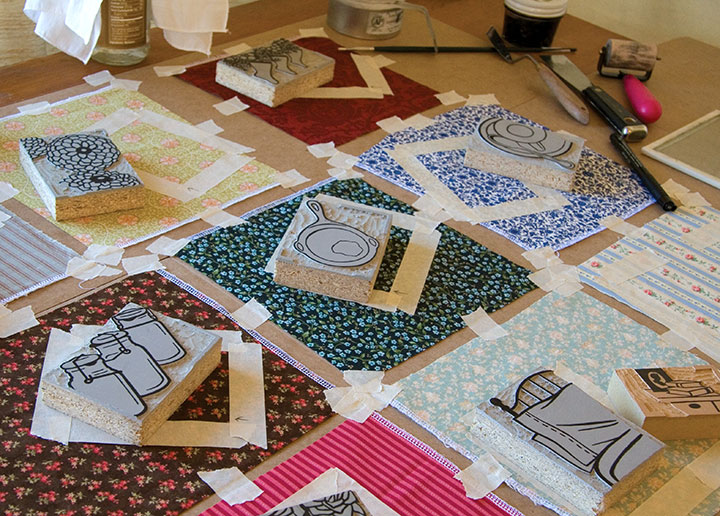
These days the studio has been an explosion of choices. Snippets of fabric and open dictionaries have taken over my life as I get ready for a new solo show, which opens October 14 at the Pacific Lutheran University Gallery. Stay tuned for more details in the next few weeks.
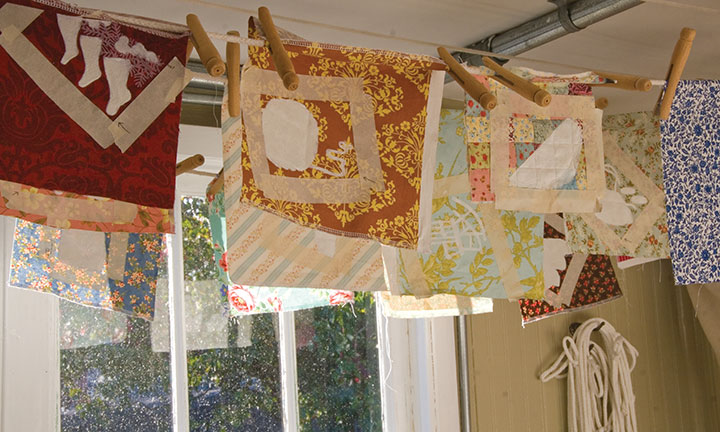
I wish I had something more concrete to show you, but this is one of those projects where everything comes together at once, right at the end (which can be as nerve-wracking as it is rewarding). I’ve got to say, though, that calico—finished or not—sure makes for pretty pictures.
September 8th, 2009
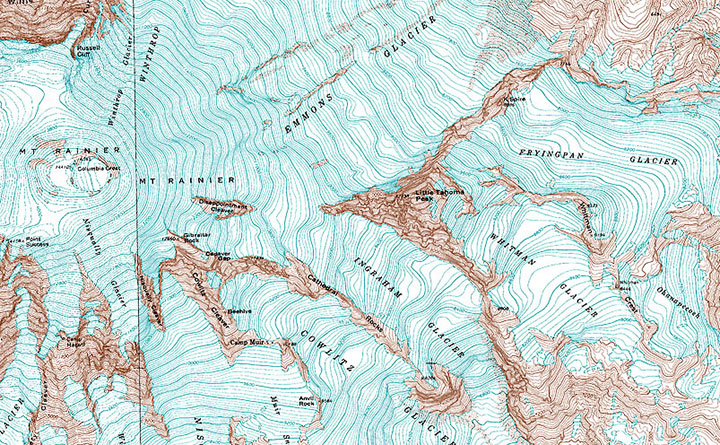
As I’ve mentioned before, I’m currently in the process of researching Mt. Rainier for my next artist book. This involves drawing and photographing the Mountain over and over (and over and over) again, in as many different conditions and from as many different vantage points as possible. I’ll get into the whys and hows some other time, but for now, suffice to say this is a huge challenge. Not only do we have incredibly unpredictable weather here, but Rainier also tends to play by his own rules, appearing and disappearing regardless of any logical connection to the forecast (which, somewhat ironically, is the entire point of my book…).
I’ve done my best to even the odds by doing the bulk of my research during the summer and early fall—traditionally the dry season here. This summer, however, has proven to be about as nontraditional as possible, and has thrown a whole lot of monkey wrenches into the works. For weeks I had planned a long trip to various points east, where the landscape is drastically different than here in the west. But here’s the rub: not only did I require a flawlessly sunny day to view the Mountain from so far away, but the best time to view Rainier from the east is in the morning—I’d have to leave too early to see that day’s weather report. So I waited, and stalked the National Weather Service, and packed and unpacked my gear. During our ridiculous heatwave we had day after day of beautiful sun, but hot weather makes the atmosphere so hazy that even from here, just forty miles away, Rainier was just a faint silhouette. And then it was one excuse after another; either I had an appointment or deadline I couldn’t change, or it was raining, or it was hot and hazy east of the Cascades, or there was a forest fire blocking my path (no joke!). Over a month went by like this, and I could feel my window of opportunity shrinking—many of the roads included in my plans are closed from October through June.
And then, a couple of weeks ago now, it seemed I’d finally get my chance. Every weather report promised dry, cool, sunny weather, for one lovely day, before the gloom closed in again. I packed my drawing paraphernalia, both cold and hot weather gear, a picnic lunch, a pile of atlases and topographic maps (you didn’t think I’d be using GPS, did you? When a letterpress printer marries a geologist, topo maps become a permanent fixture of both studio and science lab!), my camera, and plenty of music in the car, set the alarm for 3:15 am, and went to bed early with my fingers crossed.
By 3:30 I was ready to go. I poked my head outdoors, saw stars overhead, and decided to make a break for it. Two hours later I arrived at my first stop: Tipsoo Lake, just off the road in an alpine meadow. To my immense surprise I wasn’t alone, even at that absurd pre-dawn, Wednesday hour, with the entire meadow blanketed with frost. A pair of photographers arrived just minutes after me and set up tripods nearby, and a friendly Slovak couple emerged from their tent to introduce themselves while we waited for the sun to rise. The biting cold made me question the sanity of this trip, but when the light finally spilled over the ridge to dye the Mountain pink, all my doubts disappeared.
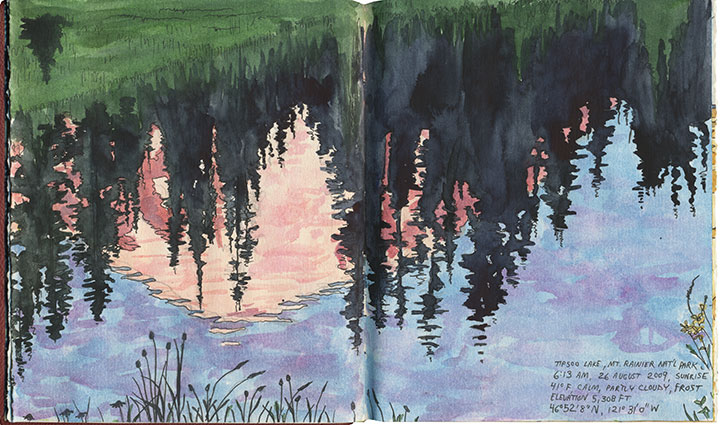
I stayed just long enough to block in a composition and shoot a few reference photos before the light changed and I lost the moment (I was on a tight timetable all day, so I finished all of these sketches back in the studio). I checked my watch and hit the road again (and waved to the Slovaks as I passed them again, thirty miles later).
From here onward I had to work entirely on conjecture. Tipsoo Lake is a famous, oft-photographed spot, so I knew what sort of composition I wanted. But I had no photo reference for the rest of my guesses that day, only an idea of what I was looking for and a lot of half-memorized topographic maps. I was hoping to capture a scene of Rainier through the iconic apple orchards of Yakima, but I knew (from all the neck-craning I’ve done on previous drives through the region) that for the most part Rainier isn’t visible from the Yakima Valley, where most of the fruit trees are. According to my maps, though, there were some flat, gridded regions at the top of the bluffs overlooking Yakima—I hoped the grid meant farms, and that the extra 600 feet in elevation would be enough for a glimpse of the Mountain. So I made for Selah Heights Road—a hairline even on my most detailed map.

The road climbed past rows of poplars, trees laden with fruit and sweeping views of the valley; so far, so good.
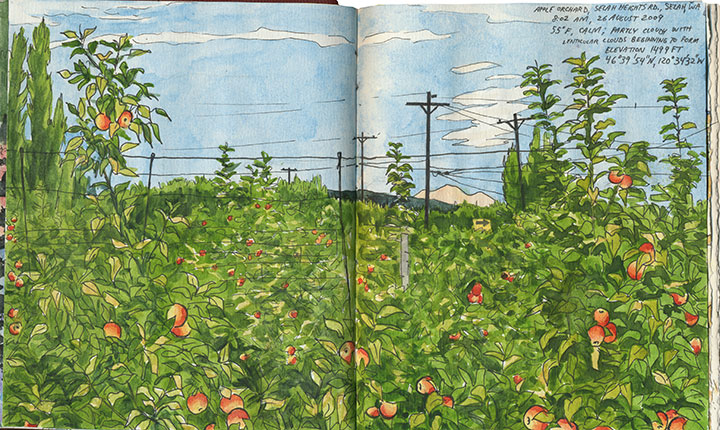
And then I found it: just the tip of Mt. Rainier visible between the apple trees. I couldn’t believe my luck. And just as I finished roughing out my drawing (I still had a lot of miles to cover before my next destination, so I worked fast and loose), I glanced to my left and discovered another treat:
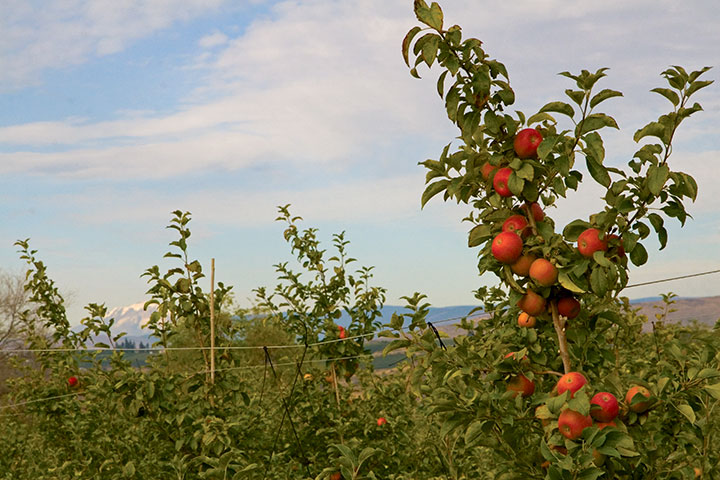
Mt. Adams, for a little extra credit.
After a quick, desperate and delicious coffee in Yakima, I turned south. My next stop was a place I’d never been: the Centerville Valley, a high-plains agricultural area just beyond Goldendale.
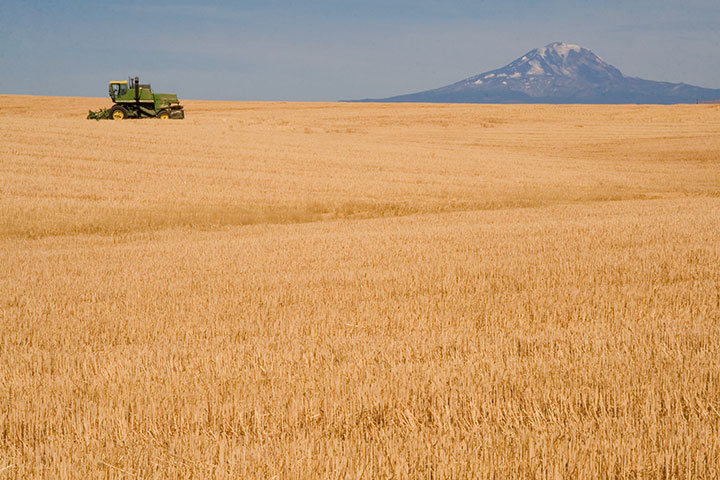
I knew that Adams would be prominently visible from here, but I could only hope that Rainier was as well—it sure would make a pretty picture if it were, I thought.
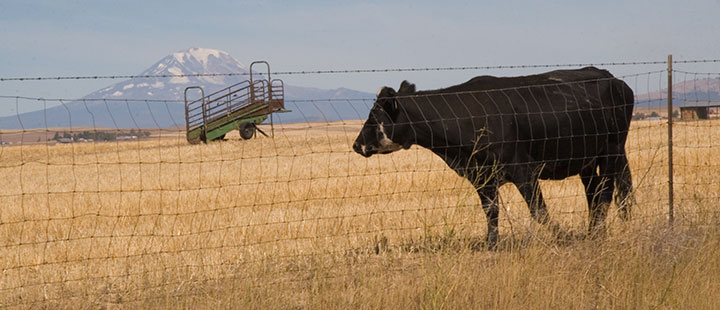
Nope, still Adams—although from this angle it tends to fool people (and cows).
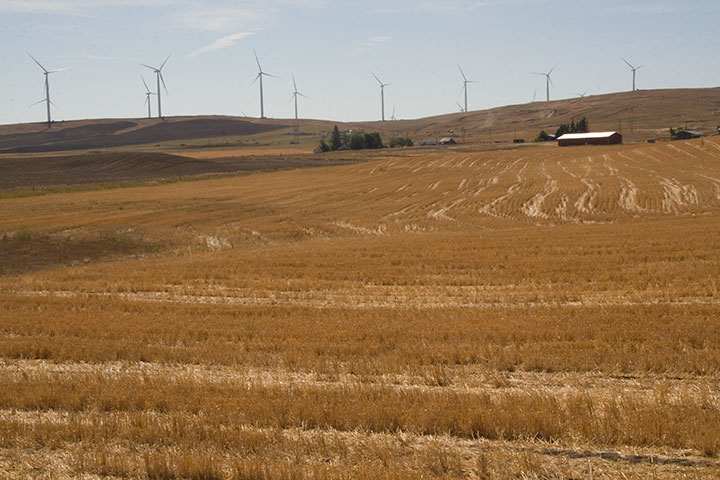
I looked behind me, and saw that the farmland sloped upward a bit, before giving way to the Columbia Hills. So I headed south along a dirt road for about a half mile, parked, and trudged a few yards into a field of wheat stubble.
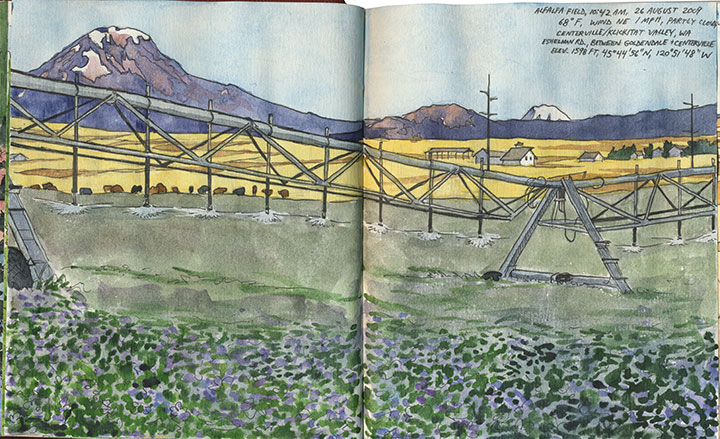
Bingo.
The alfalfa blossoms were sheer luck, just like so many other things that day. And that irrigation rig was moving—so I was never more thankful for digital photo technology than that moment (as a die-hard darkroom enthusiast, I never though I’d say that!).
Only one item remained on the itinerary: a narrow, winding goat track called the Dalles Mountain Road.
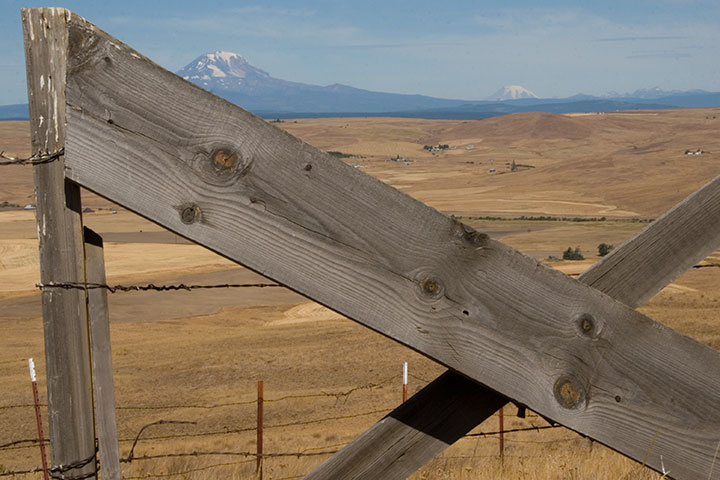
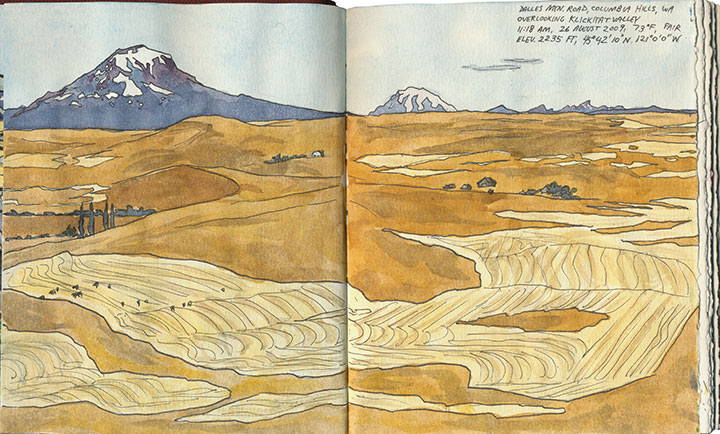
The spectacular vista of Adams, Rainier and the valley was just the beginning.
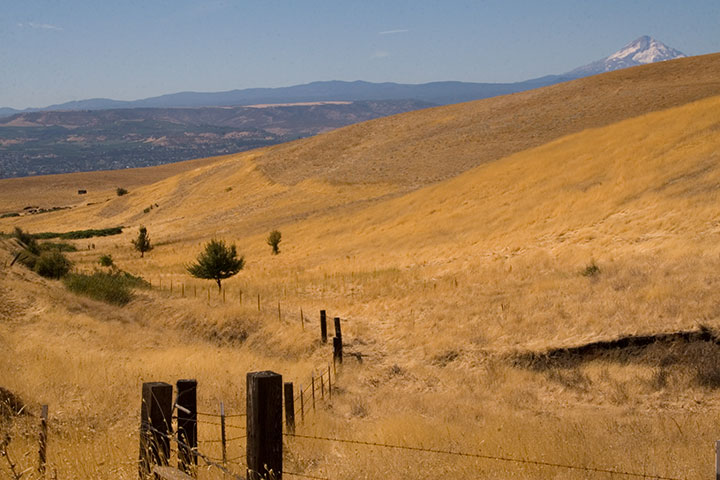
The road snakes over the top of the Columbia Hills, providing views of five volcanoes (that’s Hood there)…

pockets of stunning wildflowers…
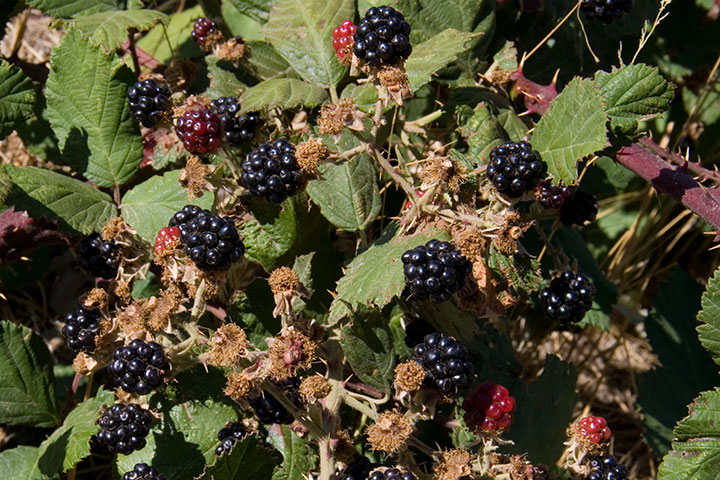
and plenty of road-side snacks.
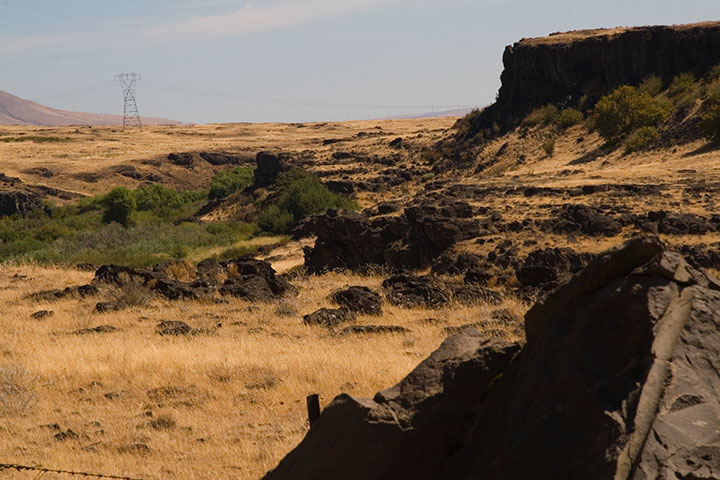
On the southern slope of the Hills the landscape turns suddenly rocky,
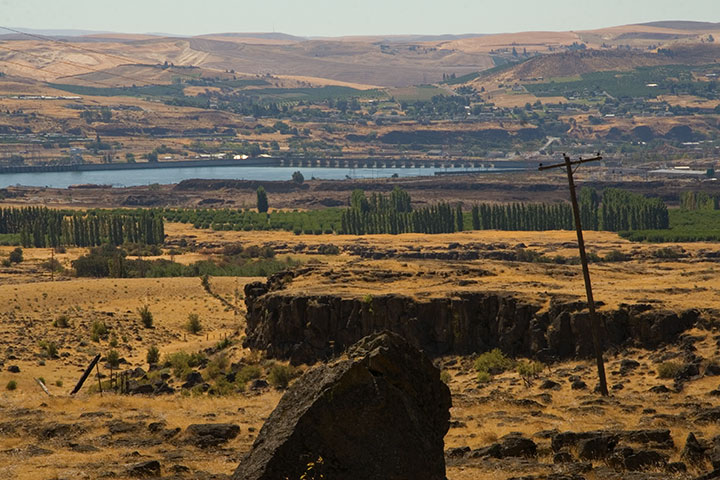
and the mighty Columbia River bursts into view.
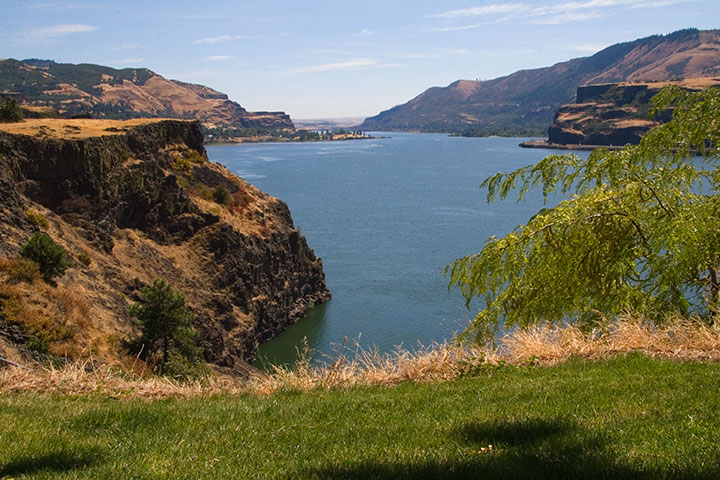
My research had gone off without a hitch, and right on schedule. It was only just noon: mission accomplished. So to celebrate I stopped for lunch at one of the most stunning picnic spots I’ve ever seen.
From that little patch of grass I could have chosen to go home the way I came, or finish the loop and return along the western side of the Cascades—it was almost perfectly equidistant. So as usual I chose the unknown road, and zipped home via the historic Columbia River Highway.
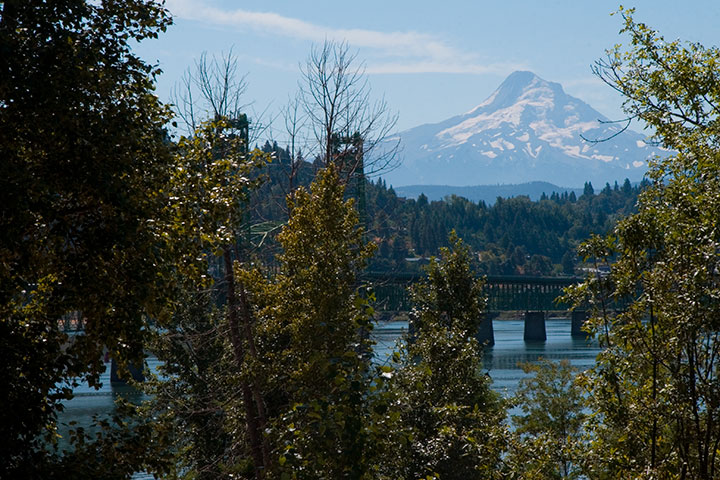
Fifteen hours, 515 miles roundtrip. And perfect conditions every step of the way. I think that after a summer of total frustration (remember the airplane incident?), maybe the universe decided to give me a break.
I’ll be sure to send a thank-you note.
July 20th, 2009
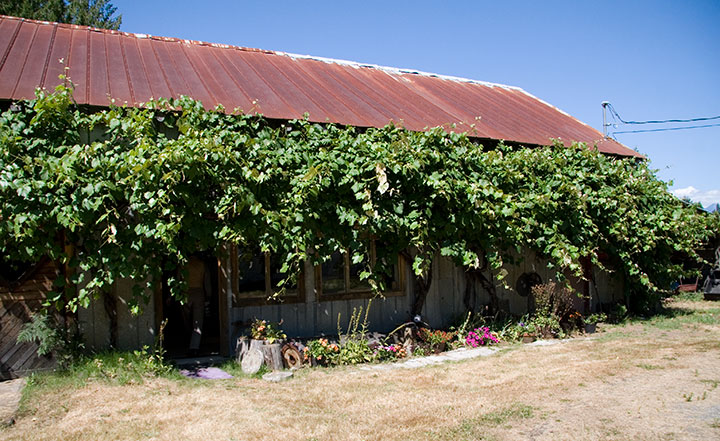
I serve on the board of the Book Arts Guild, a group that started as little gathering place for like-minded souls in the Pacific Northwest. It has since spiraled outward to include hundreds of members in all corners of the art form and the country—and suddenly thirty years have gone by. On Saturday fifty or so of us got together to celebrate the occasion at the Stern & Faye “Printing Farm” in the Skagit Valley.
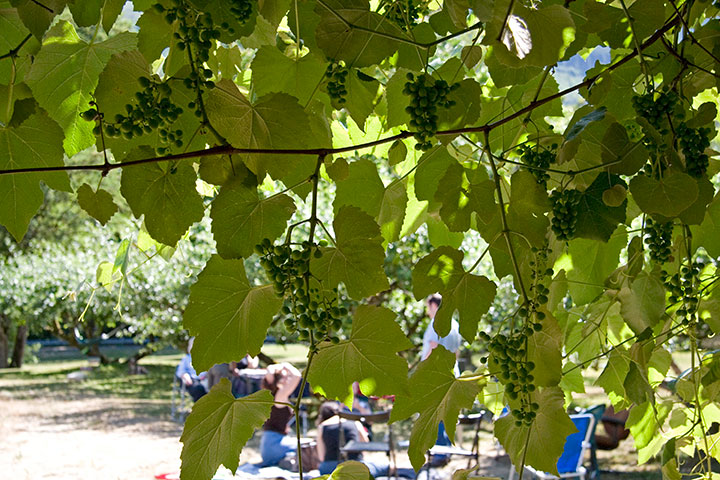
We couldn’t have asked for a better day—I could have stayed all afternoon in the orchard, chatting with kindred spirits.

I had heard so much about the studio, however—so while most of the group was drawing for prizes in the loft,
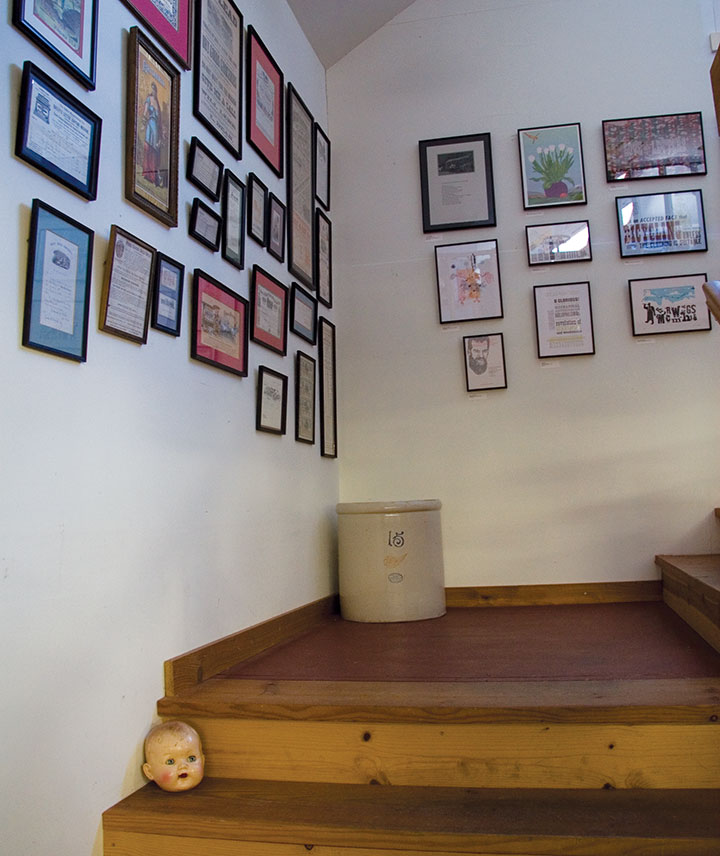
I wandered downstairs to do a bit of exploring.
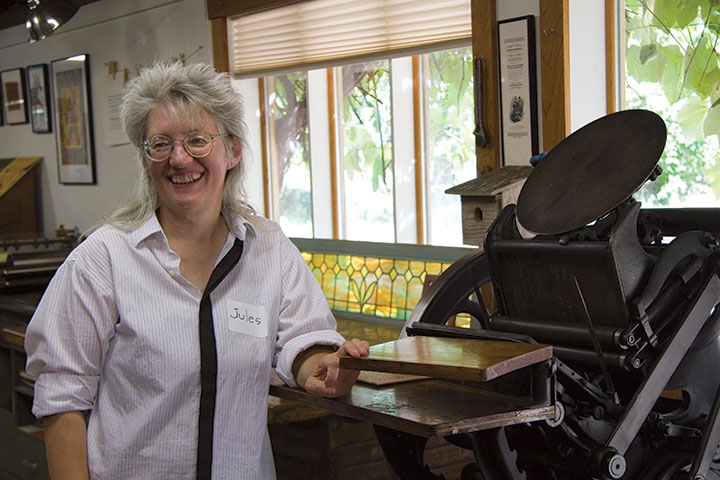
This is Jules Remedios Faye, “Proprietrix” of the Farm. She and her husband, Chris Stern, moved to the Skagit Valley fourteen years ago and turned an old barn into a letterpress printer’s dream.

The space is at once cozy and seemingly never-ending,

serving as both a working studio and a living relic.
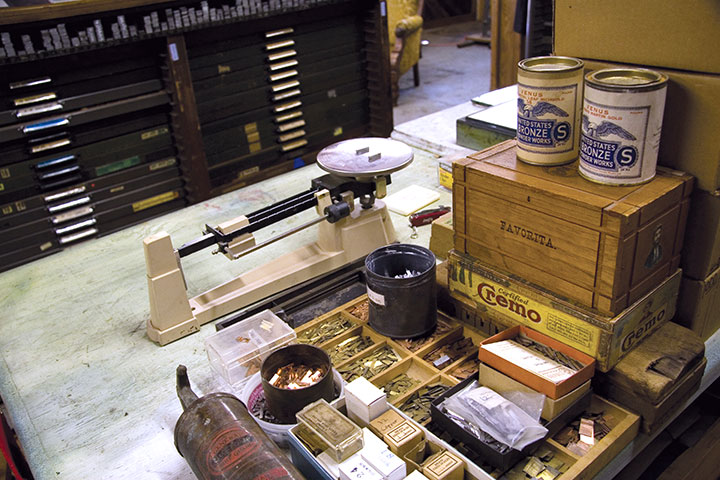
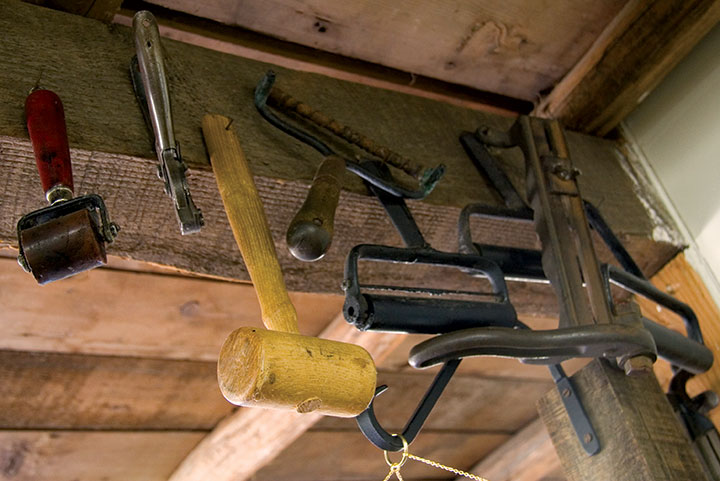
The place is chock-a-block with tools, type and ephemera, and functions as a type foundry as well—one of a small and dwindling number remaining in the U.S. these days.

After Chris passed away in 2006, Jules was forced to scale back the studio a bit to continue managing it alone. The barn is still very much alive, though—the walls are festooned with prints, and evidence of well-loved and continuing use is all around. It feels like their space, not just hers.
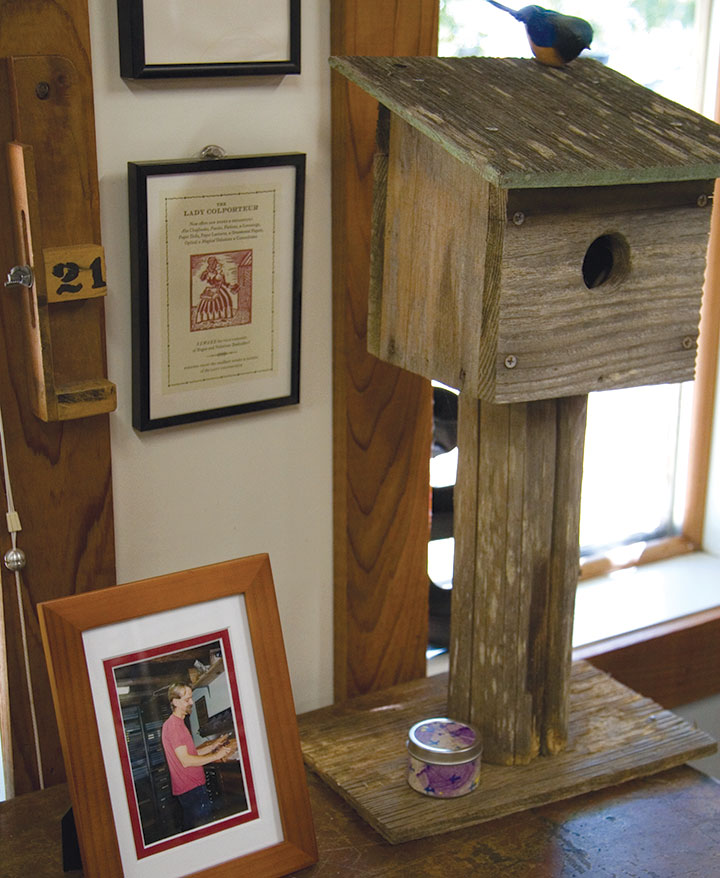
His presence is everywhere—a fitting memorial.
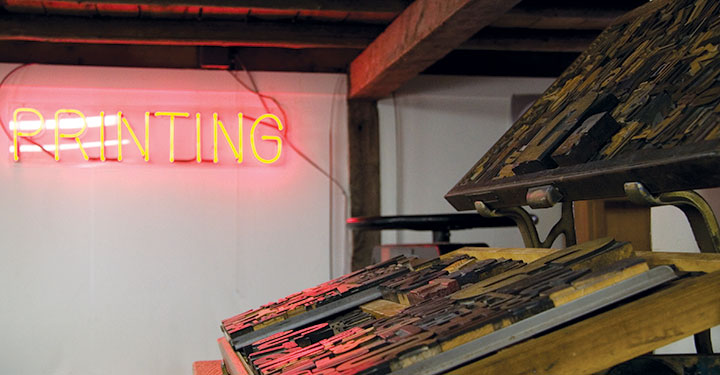
The Printing Farm was the absolute best-possible place to celebrate the anniversary of the Book Arts Guild. It served as a touching reminder that no matter how far into the past our roots go, no matter who has gone before us or what new trends have appeared, we’re still here—still breathing, still practicing, still creating.
After all, that’s what we’re here for.






![Chandler O'Leary [logo]](https://chandleroleary.com/wp-content/themes/chandleroleary/images/logo.png)































































